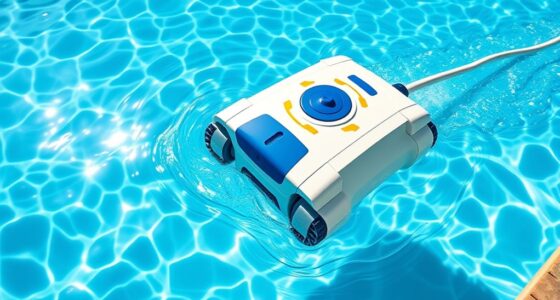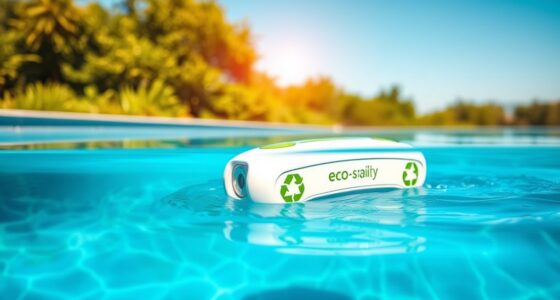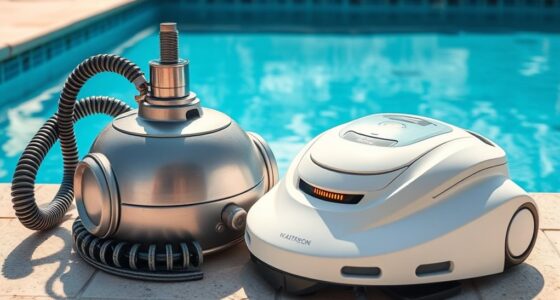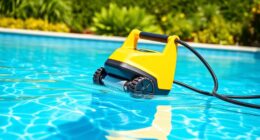Market trends show that robotic pool cleaners are increasingly replacing traditional suction models as more people seek low-maintenance, automated solutions. Advances in smart navigation, sensors, and remote control features make robots more efficient and user-friendly. Consumers tend to favor these modern options over manual cleaning methods. If you want to understand how these shifts could impact your pool care routine and which cleaner might suit your needs, you’ll find useful insights ahead.
Key Takeaways
- Growing consumer preference for low-maintenance, automated robotic cleaners is reducing demand for traditional suction pool cleaners.
- Advances in robotic technology, including smart navigation and sensors, outperform suction models in cleaning efficiency.
- Market share for robotic pool cleaners is steadily increasing, overtaking traditional suction units in many regions.
- Cost and performance variations favor robotic cleaners with advanced features, prompting a shift in consumer purchasing habits.
- Industry trends indicate a future focus on AI-driven, hybrid cleaning solutions, further diminishing the role of manual suction cleaners.
Evolution of Pool Cleaning Technologies

The evolution of pool cleaning technologies has been driven by the desire to make maintenance easier and more efficient. In the past, you relied heavily on manual maintenance, which involved scrubbing filters, skimming debris, and adjusting chemical balancing by hand. These tasks were time-consuming and often inconsistent. Over time, innovations emerged to simplify this process. Chemical balancing, once a tedious task, has become more precise with automated testers and controllers, ensuring your pool’s water stays safe and clear. As technology advanced, manual maintenance gave way to semi-automated systems, paving the way for fully automated cleaners. This shift has drastically reduced your workload, allowing you to enjoy a cleaner pool with less effort and more consistent results.
Consumer Preferences and Market Share Shifts
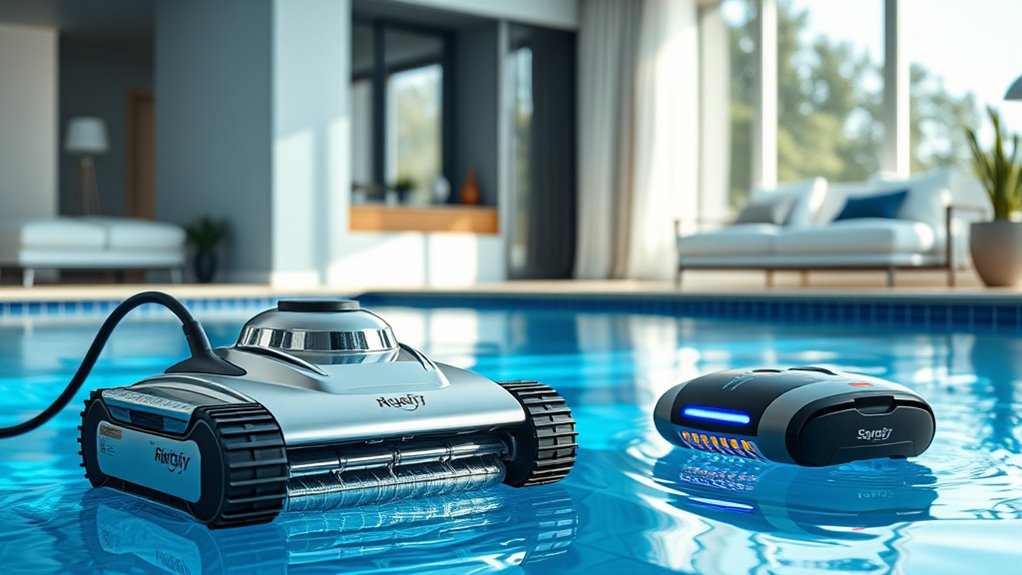
As consumer preferences evolve, many pool owners now prioritize automated and low-maintenance cleaning solutions, which has markedly influenced market dynamics. You’re more likely to choose a robot that requires minimal manual maintenance, saving you time and effort. Brand loyalty also plays a significant role; trusted brands often retain customers even as new options emerge. Many consumers shift away from traditional suction pool cleaners, favoring robotic models that offer smarter, more efficient cleaning. You might stick with a familiar brand because of positive past experiences or perceived reliability. These preferences lead to market share shifts, with robotic cleaners gaining ground while manual maintenance methods decline. Additionally, technological innovation and the development of more sophisticated navigation systems continue to shape consumer choices and industry competition. For example, navigation systems enable robots to cover pools more thoroughly and efficiently, further influencing buyer preferences. The integration of smart features such as app control and scheduling also enhances the appeal of robotic cleaners. Moreover, consumers are increasingly valuing user-friendly interfaces, which make operation more intuitive and accessible. Overall, your desire for convenience and quality influences industry trends and the competitive landscape.
Innovations in Robotic Pool Cleaners

Recent innovations in robotic pool cleaners have dramatically enhanced their efficiency and user convenience. You now benefit from advanced features like smart navigation, which allows the robot to map your pool and clean systematically, avoiding missed spots. Maintenance automation has made upkeep easier, with self-cleaning brushes and automatic debris disposal. Here are four key innovations:
- Smart navigation systems that optimize cleaning routes. These systems often incorporate sensors to detect obstacles and ensure thorough coverage.
- Maintenance automation reducing manual upkeep.
- Enhanced sensors for better obstacle detection.
- Wireless connectivity enabling remote control and scheduling.
- The integration of user-friendly interfaces ensures even first-time users can operate and customize their cleaning routines effortlessly. Additionally, track development techniques are being incorporated into some models to further improve efficiency and coverage. These developments mean your robotic cleaner operates more intelligently and with less intervention, making pool maintenance simpler and more effective. The focus on smart navigation and automation reflects a shift toward more autonomous, user-centric pool cleaning solutions.
Comparative Performance and Cost Analysis
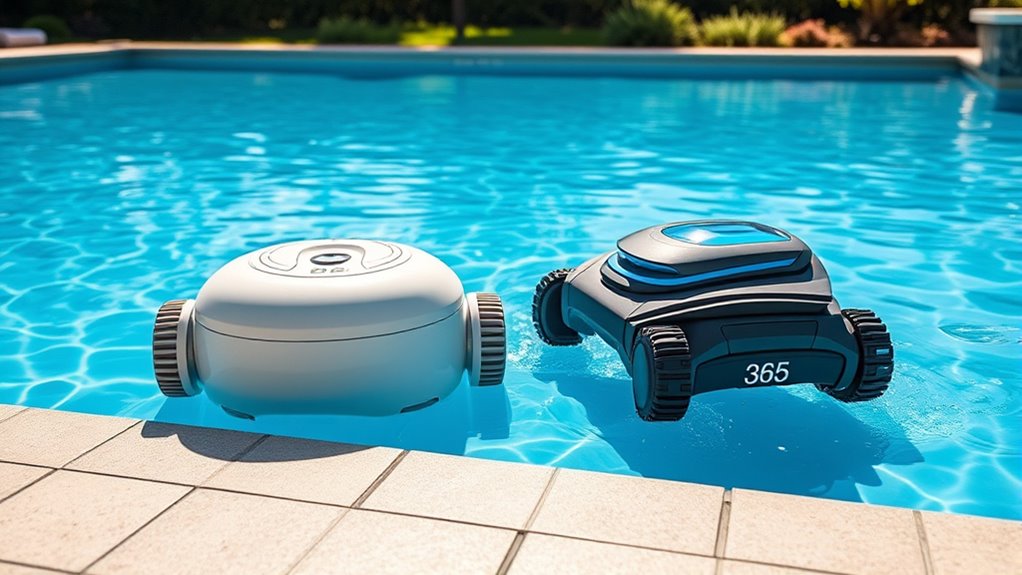
While robotic pool cleaners have become increasingly sophisticated, their performance and cost vary widely across models, making it essential for you to compare options carefully. Some models excel in cleaning coverage and navigation, reducing manual maintenance, while others fall short, requiring more hands-on effort. Cost differences reflect features like advanced sensors and longer-lasting parts, but higher prices don’t always guarantee better performance. Energy efficiency is another key factor; more efficient models consume less power and save you money over time. When evaluating options, consider how well each cleaner navigates your pool, the level of manual maintenance needed, and their long-term operating costs. A balanced comparison helps you choose a model that offers the best value for your budget and cleaning needs. Additionally, understanding performance metrics can help you make a more informed decision regarding your pool cleaning needs. Incorporating technological advancements into your assessment can reveal improvements in navigation and cleaning efficiency. Furthermore, assessing cost-to-performance ratio can guide you toward models that deliver optimal results without unnecessary expenditure. Recognizing the market trends in robotic pool cleaners can also help you stay ahead of emerging features and innovations. It is also beneficial to consider customer reviews and real-world performance reports to gauge reliability and user satisfaction.
Future Outlook for Pool Cleaning Solutions
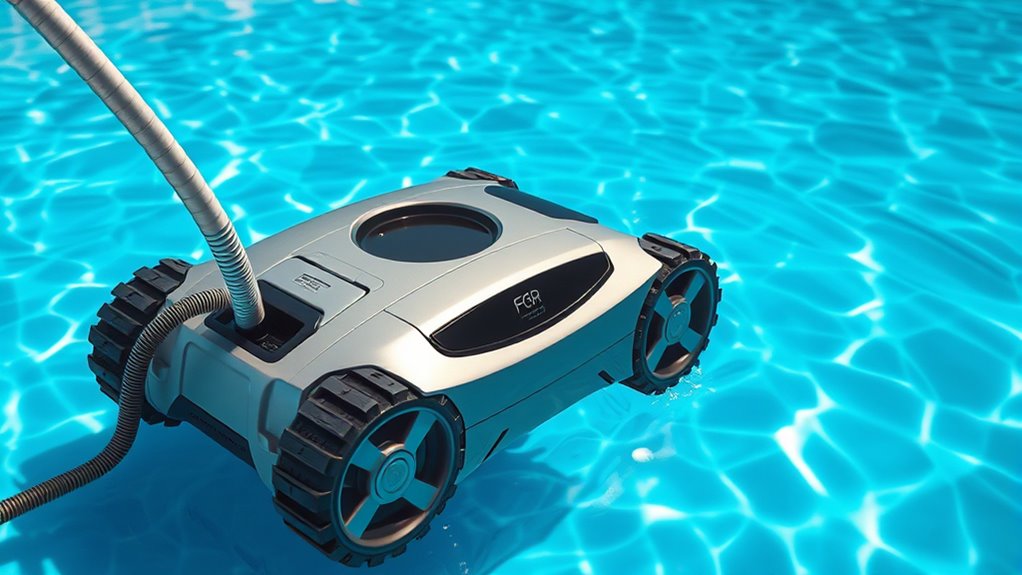
Advancements in technology are poised to revolutionize pool cleaning solutions in the coming years. You’ll see smarter, more autonomous systems that reduce manual maintenance and improve aesthetic considerations. Here are four key trends to watch:
- AI-powered robots that adapt to pool layouts, ensuring thorough cleaning with minimal effort. These systems utilize machine learning algorithms to optimize cleaning paths and adapt to different debris types. Incorporating advanced navigation technology will allow these robots to better maneuver around complex pool shapes and obstacles. As these systems become more sophisticated, they will also leverage Volkswagen Tuning principles of performance enhancement to optimize their operational efficiency and durability.
- Integrated systems combining suction and robotic features for ideal performance.
- Enhanced sensors that detect debris and prioritize cleaning zones, saving time.
- Smart connectivity allowing remote monitoring and control, making maintenance easier.
- Additionally, innovations inspired by Honda Tuning modifications, such as performance upgrades and sensor integrations, are expected to influence the development of smarter pool cleaning technologies.
These innovations will make pool upkeep more efficient, less manual, and visually appealing. Expect future solutions to seamlessly blend convenience with superior cleaning, transforming how you maintain your pool’s appearance and hygiene.
Frequently Asked Questions
What Are the Environmental Impacts of Robotic Versus Suction Pool Cleaners?
Robotic pool cleaners tend to be more environmentally friendly than suction models because they often use less energy, reducing overall energy consumption. They also generate less chemical runoff, as they clean more efficiently and require fewer chemicals for maintenance. Suction cleaners, on the other hand, may use more power and potentially cause more chemical runoff if they disturb contaminants or debris, impacting water quality and surrounding ecosystems.
How Do Maintenance Requirements Compare Between Suction and Robotic Pool Cleaners?
Imagine your pool as a busy highway—suction cleaners are like simple toll booths, easy to maintain but needing regular filter checks. Robotic cleaners, like high-tech toll plazas, require less filter maintenance but may consume more energy. You’ll spend time cleaning filters on suction models, while robotic ones need occasional software updates. Overall, suction cleaners are straightforward but demand consistent upkeep; robotic cleaners offer convenience but at a different energy and maintenance balance.
Are There Specific Pool Sizes or Types Better Suited for Robotic Cleaners?
You should consider pool size suitability and pool type compatibility when choosing robotic cleaners. Larger pools may require more advanced models with longer battery life, while smaller pools are easier for robotic cleaners to handle efficiently. Additionally, in pools with complex shapes or features, robotic cleaners excel due to their maneuverability. Overall, robotic cleaners are versatile, but matching the right model to your pool’s size and type guarantees ideal cleaning performance.
What Safety Concerns Are Associated With Robotic Pool Cleaning Devices?
You might find it surprising, but safety concerns with robotic pool cleaners include electrical hazards if they’re not properly maintained, and mechanical malfunctions that could cause damage or injury. While these devices are designed with safety features, accidental exposure to water or faulty wiring can pose risks. Regular inspections and proper use help minimize these dangers, ensuring your robotic cleaner operates safely and efficiently, giving you peace of mind.
How Do User Experiences Vary Between Traditional Suction and Robotic Pool Cleaners?
You’ll notice that user experiences differ between traditional suction and robotic pool cleaners. With traditional models, you might find more noise and less user comfort during operation, as they often require manual setup and supervision. Robotic cleaners, on the other hand, usually offer quieter operation and are more user-friendly, providing a more comfortable experience. This makes robotic options appealing if you prioritize ease of use and lower noise levels.
Conclusion
As you consider your pool cleaning options, it’s clear that robotic cleaners are gaining ground, now capturing over 60% of the market share. With innovations like AI navigation and energy efficiency, they’re becoming more appealing than traditional suction models. If you want a hassle-free, tech-savvy solution that saves time and effort, adopting a robotic cleaner could be your best move. The trend shows that embracing automation now means enjoying a cleaner pool tomorrow.


